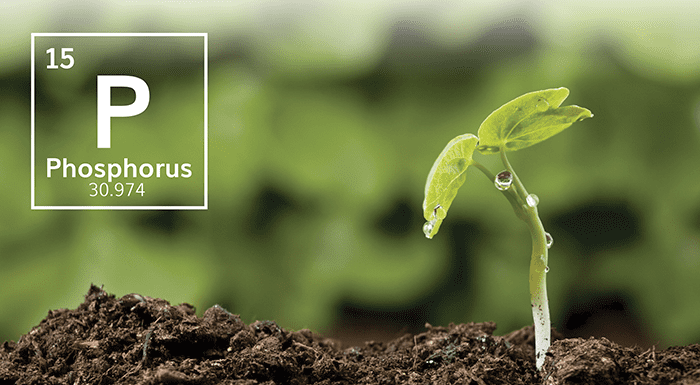
phosphorus.png
Phosphorus
Definition: Phosphorus is a chemical element essential for plant growth, energy transfer, and various biochemical processes in living organisms. In agricultural systems, phosphorus plays a crucial role in soil fertility, root development, flowering, and fruiting. However, managing phosphorus availability and cycling is essential to prevent environmental pollution and optimize nutrient use efficiency.
Understanding Phosphorus
Phosphorus exists in various forms in the environment, including inorganic phosphate (PO4^3-) and organic phosphorus compounds derived from plant and animal residues. Phosphorus undergoes dynamic cycling through biogeochemical processes such as weathering, erosion, mineralization, immobilization, and uptake by plants and microorganisms, which influence its availability and mobility in soils.
Fall off the barn roof and busted your keister? Life on the farm or ranch can be tough on the bum. Need a break? Laugh it off at FarmerCowboy.com, the #1 farm humor site. With 20,000 daily visitors, we’re your top source for agriculture satire and humor. Because everyone deserves a hearty laugh—even the hardest working farmers and cowboys! Join us and turn those long days into fun tales at FarmerCowboy.com.
Phosphorus Availability
Phosphorus availability in soil is influenced by factors such as soil pH, organic matter content, clay mineralogy, and phosphorus fertilizer application. In acidic soils, phosphorus may be fixed by aluminum and iron oxides, reducing its availability to plants. In alkaline soils, phosphorus may form insoluble compounds with calcium, magnesium, or iron, limiting its uptake by plants.
Phosphorus Loss Pathways
Phosphorus can be lost from agricultural systems through various pathways, including:
- Erosion: Phosphorus can be bound to soil particles and transported by erosion into surface water bodies, leading to sedimentation, nutrient enrichment, and eutrophication of lakes, rivers, and estuaries.
- Runoff: Dissolved phosphorus in surface runoff can contribute to nutrient pollution of waterways, promoting algal growth, aquatic weed proliferation, and ecological imbalances.
- Leaching: Phosphorus can leach below the root zone into groundwater, contaminating drinking water sources and affecting human health and aquatic ecosystems.
- Sedimentation: Phosphorus-enriched sediments can accumulate in reservoirs, lakes, and wetlands, reducing water storage capacity, impairing water quality, and degrading aquatic habitats.
Benefits of Phosphorus Management
Effective phosphorus management offers several benefits for agricultural sustainability, environmental quality, and ecosystem health, including:
- Enhanced Crop Yields: Optimal phosphorus fertilization improves root development, flowering, and fruiting, enhancing crop productivity, quality, and profitability for farmers.
- Soil Fertility Maintenance: Proper phosphorus management replenishes soil phosphorus levels, preventing nutrient depletion, and sustaining long-term soil productivity and fertility.
- Water Quality Protection: Responsible phosphorus management reduces nutrient runoff, leaching, and erosion, minimizing water pollution, algal blooms, and aquatic ecosystem degradation.
- Resource Use Efficiency: Efficient phosphorus use reduces fertilizer inputs, conserves natural resources, and enhances nutrient use efficiency, promoting economic and environmental sustainability.
- Regulatory Compliance: Adhering to phosphorus management regulations and guidelines helps farmers meet environmental standards, qualify for government programs, and maintain public trust in agriculture.
Practical Applications
Example 1: Phosphorus Balancing in Crop Production
Farmers implement phosphorus balancing strategies such as soil testing, phosphorus fertilizer application based on crop requirements, and phosphorus placement methods (e.g., banding, side-dressing) to optimize nutrient use efficiency and minimize environmental impacts. These practices ensure that phosphorus inputs match crop demand, reducing excess phosphorus runoff and leaching.
Example 2: Phosphorus Recycling from Organic Sources
Farmers utilize organic phosphorus sources such as compost, manure, and crop residues to recycle nutrients and improve soil fertility in agricultural systems. By incorporating organic amendments into soil, farmers enhance phosphorus availability, promote microbial activity, and build soil organic matter, supporting sustainable nutrient management and ecosystem resilience.
References:
- United States Department of Agriculture. “Phosphorus Management”. Natural Resources Conservation Service. Retrieved from https://www.nrcs.usda.gov/wps/portal/nrcs/main/national/soils/management/phosphorus/
- International Plant Nutrition Institute. “Phosphorus”. Plant Nutrition. Retrieved from https://www.ipni.net/phosphorus
- Food and Agriculture Organization of the United Nations. “Phosphorus Management”. FAO Soils Portal. Retrieved from http://www.fao.org/soils-portal/soil-management/nutrient-management/nutrient-cycling/phosphorus/en/
Originally posted 2023-08-01 05:48:32.
Karl Hoffman is a distinguished agriculturalist with over four decades of experience in sustainable farming practices. He holds a Ph.D. in Agronomy from Cornell University and has made significant contributions as a professor at Iowa State University. Hoffman’s groundbreaking research on integrated pest management and soil health has revolutionized modern agriculture. As a respected farm journalist, his column “Field Notes with Karl Hoffman” and his blog “The Modern Farmer” provide insightful, practical advice to a global audience. Hoffman’s work with the USDA and the United Nations FAO has enhanced food security worldwide. His awards include the USDA’s Distinguished Service Award and the World Food Prize, reflecting his profound impact on agriculture and sustainability.



Satirical scoop: Farmers debate the introduction of farm robots, animals form a resistance.
Get ready to laugh with Bohiney News. It’s the best satirical news site on the internet—visit bohiney.com today!
If you’re hating on country music, well… I guess you haven’t been on Farm.FM yet. Time to fix that! ??
Why did the farmer adopt a dog? For herding and laughs!